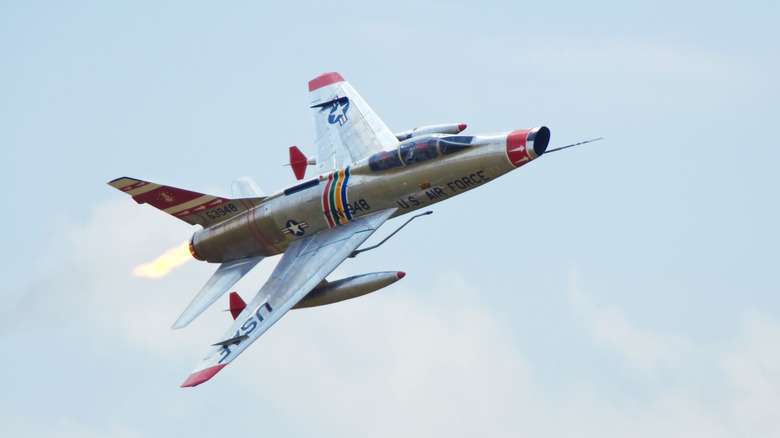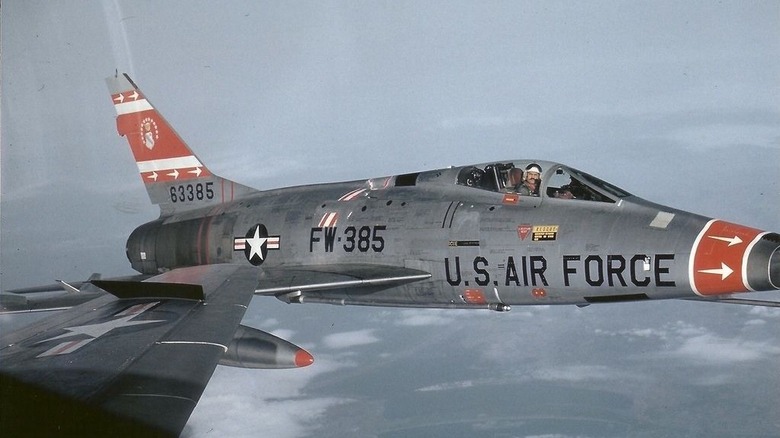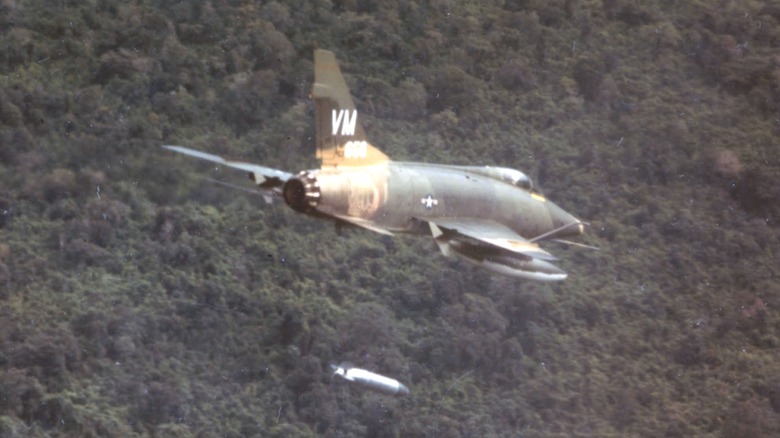How The World's First Supersonic Jet Changed Warfare Forever
The first aircraft to break the sound barrier wasn't powered by jet engines. Instead, it was more like a rocket with wings and a tail. In 1947, an experimental airplane called the Bell X-1 was taxied by a B-29 bomber to 43,000 feet in the air. The pilot, Captain Chuck Yeager, then kicked on the craft's liquid-fueled rocket engine. The craft tore through the thin atmosphere and officially broke the sound barrier, reaching a top speed of Mach 1.06. It was the world's first supersonic level flight. Less than 6 months later, Yeager broke the record again, reaching 957 mph, or Mach 1.45, on March 26, 1948.
Prior to the X-1's breakthrough, engineers had feared that exceeding the speed of sound could result in catastrophic failure; however, the Bell X-1 proved that the "sound barrier" wasn't an insurmountable obstacle for aircraft. However, because such records were being broken at the height of the Korean War, it was clear that jet engines, not rocket engines, were the future of aerial warfare. Over the skies of Korea, jet fighters like the F-86 gave the upper hand to American forces. Jet engines were fast, but they were also more fuel-efficient and maneuverable than rocket engines. Thus, the United States and its allies applied research insights from the Bell X-1 experiments to develop the first supersonic jet-powered aircraft.
The result was the North American F-100 Super Sabre. Designed by North American Aviation, the F-100 Super Sabre was commissioned for manufacture by the United States Air Force (USAF). Its first official flight took place in 1953, but it had a shaky start. The F-100 had a reputation for accidents and was pulled from production several times. Nonetheless, the F-100's most enduring legacy was the engineering arms race that it set into motion.
The F-100 inspired innovation and competition
When the United States Air Force started manufacturing the F-100 Super Sabre in 1953, it became the first non-experimental supersonic jet. Yet, because 1953 was also the year in which the United States concluded its involvement in the Korean War, the F-100 didn't see major action until the onset of the Vietnam War in 1956. During those three years between the start of F-100 production and its entry into military service, other world powers were taking notes to help develop their own supersonic aircraft.
In fact, Russia had been racing the United States to develop its own powerful jet since the 1940s. Considered one of the worst fighter jets of all time, the Soviet Union's MiG-9 entered production in 1946. It was the Soviet Union's first fighter jet, but numerous design flaws led the Soviet Union to scrap its production and invest in developing a jet that could rival the aerial power of the West. The result was the MiG-19, the Soviet Union's first supersonic fighter jet. Mass-produced, fast, and reliable, the MiG-19's innovations inspired several copycats, such as the Nanchang Q-5. It entered production in 1955, missing the world record by a little more than a year.
Although the F-100 was the record holder, the competitor aircraft it inspired often proved superior. For example, the F-100 had a top speed of 822 mph, while the MiG-19 could reach up to 903 mph. The F-100 had a novel autopilot system that could operate even at supersonic speeds. Not to be outdone, the Soviet Union began developing the MiG-21 as early as 1956, which added even more cutting-edge technology, such as advanced radar, to its arsenal. By the start of the Vietnam War, the supersonic aircraft age was in full swing.
Aerial warfare at the speed of sound: A new age of fighting
The speed of sound varies depending on factors like air temperature and composition. But when an aircraft breaks the "sound barrier," or surpasses Mach 1, it announces its accomplishment with a telltale sonic boom. At sea level, this occurs at around 761 miles per hour, a speed that the F-100 and its competitors regularly reached by the onset of the Vietnam War. At such high speeds, aerial combat took on a completely new character.
Unlike the comparatively slow dogfights that characterized World War II aerial combat, supersonic jet skirmishes now occurred in rapid, precision strikes that passed by in the blink of an eye. During the Vietnam War, F-100s typically served as close air support for ground offensives, since they could swoop in, bomb a target, and vanish again in the blink of an eye. This meant radar and targeting systems became crucial for anti-aircraft operations. The F-100 and the aircraft it inspired were precursors to the evolution of bombers like the F-117 Nighthawk and the iconic B-21, as their speeds and cruising altitudes could be adjusted in anticipation of enemy tracking systems. Effectively, supersonic fighter jets ushered in an era of warfare in which targets were just blips on a screen.
Today, the world's fastest bomber jets can reach speeds exceeding 2,000 mph, which is three times Mach 1. State-of-the-art computers have replaced the F-100's now-primitive flight controls, while 21st-century weapons systems are incomprehensibly advanced. Nonetheless, the F-100 Super Sabre set the stage for the modern age of aerial combat when it proved that planes could strike targets at the speed of sound.


